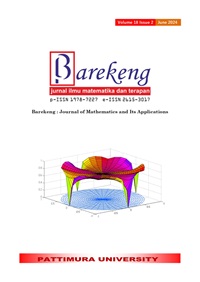GROUPING PROVINCES IN INDONESIA BASED ON THE NUMBER OF VILLAGES AFFECTED BY ENVIROMENTAL POLLUTION WITH K-MEDOIDS, FUZZY C-MEANS, AND DBSCAN
Abstract
Pollution can cause the environment to not function properly and ultimately harm humans and other living things. Environmental pollution is a problem that needs to be resolved because it involves the safety, health, and survival of living things. Air pollution in Pekanbaru due to a long dry season has resulted in forest fires. Then, 70% of drinking water is contaminated by fecal waste. In addition, the contamination of the land by the Chevron company resulted in residents suing the company. Until now, there has been no research that has carried out a comparison between methods for grouping villages affected by environmental pollution at the provincial level in Indonesia, so it is important to select the best method for carrying out the grouping. The limitations of this research are the use of three methods for clustering: K-Medoids, Fuzzy C-Means, and DBSCAN. The results showed that Fuzzy C-Means with five clusters have an optimal value compared to DBSCAN with an ICD rate value of 0,351. This method can be used by the government to improve the quality of villages that are clean from pollution in Indonesia, monitoring and evaluation based on the clusters formed.
Downloads
References
M. S. Muslimah and S. Si, “Dampak pencemaran tanah dan langkah pencegahan,” J. Penelit. Agrisamudra, vol. 2, no. 1, pp. 11–20, 2017.
UNICEF., “Indonesia: Nearly 70 percent of household drinking water sources contaminated by faecal waste,” 2022. https://www.unicef.org/indonesia/press-releases/indonesia-nearly-70-cent-household-drinking-water-sources-contaminated-faecal-waste (accessed Feb. 07, 2022).
F. Yazid and M. Affandes, “Clustering Data Polutan Udara Kota Pekanbaru dengan Menggunakan Metode K-Means Clustering,” J. CoreIT, vol. 3, no. 2, p. 1, 2017.
M. Syukur, “Menelisik Dugaan Pencemaran Lingkungan oleh Perusahaan Minyak di Riau,” LIPUTAN 6, 2021. https://www.liputan6.com/regional/read/4600332/menelisik-dugaan-pencemaran-lingkungan-oleh-perusahaan-minyak-di-riau
R. Sitepu, I. Irmeilyana, and B. Gultom, “Analisis cluster terhadap tingkat pencemaran udara pada sektor industri di Sumatera Selatan,” J. Penelit. sains, vol. 14, no. 3, 2011.
C. B. of Statistics, Village Potential Statistics. JAKARTA: BPS, 2021. [Online]. Available: http://www.bps.go.id/
Joseph F. Hair, Multivariate Data Analysis, vol. 7. 2010. doi: 10.3390/polym12123016.
N. Nasir and S. Sukmawati, “Analysis of Research Data Quantitative and Qualitative,” Edumaspul J. Pendidik., vol. 7, no. 1, pp. 368–373, 2023.
D. Marlina, N. F. Putri, A. Fernando, and A. Ramadhan, “Implementasi Algoritma K-Medoids dan K-Means untuk Pengelompokkan Wilayah Sebaran Cacat pada Anak,” J. CoreIT, vol. 4, no. 2, p. 64, 2018.
A. Aryandani, N. Solimun, A. A. Rinaldo Fernandes, and A. Efendi, “Implementation of FCM in Investor Group in the Stock Market Post-Covid-19 Pandemic,” WSEAS Trans. Math., vol. 21, pp. 415–423, 2022.
J. C. Bezdek, Pattern recognition with fuzzy objective function algorithms. Springer Science & Business Media, 2013.
M. Zhang, “Use density-based spatial clustering of applications with noise (DBSCAN) algorithm to identify galaxy cluster members,” in IOP conference series: earth and environmental science, 2019, vol. 252, no. 4, p. 42033.
B. N. Sari and A. Primajaya, “Penerapan clustering DBSCAN untuk pertanian padi di kabupaten Karawang,” JIKO (Jurnal Inform. dan Komputer), vol. 4, no. 1, pp. 28–34, 2019.
B. S. Ashari, S. C. Otniel, and R. Rianto, “Perbandingan Kinerja K-Means dengan DBSCAN untuk Metode Clustering data Penjualan Online Retail,” J. Siliwangi Seri Sains dan Teknol., vol. 5, no. 2, pp. 64–67, 2019.
N. Nurhaliza and M. Mustakim, “Pengelompokan Data Kasus Covid-19 di Dunia Menggunakan Algoritma DBSCAN: Clustering of Data Covid-19 Cases in the World Using DBSCAN Algorithms,” Indones. J. Inform. Res. Softw. Eng., vol. 1, no. 1, pp. 1–8, 2021.
J.-S. R. Jang, C.-T. Sun, and E. Mizutani, “Neuro-fuzzy and soft computing-a computational approach to learning and machine intelligence [Book Review],” IEEE Trans. Automat. Contr., vol. 42, no. 10, pp. 1482–1484, 1997.
S. A. Mingoti and J. O. Lima, “Comparing SOM neural network with FCM, K-means and traditional hierarchical clustering algorithms,” Eur. J. Oper. Res., vol. 174, no. 3, pp. 1742–1759, 2006.
Copyright (c) 2024 Idrus Syahzaqi, Magdalena Effendi, Hasri Rahmawati, Heri Kuswanto, Sediono Sediono

This work is licensed under a Creative Commons Attribution-ShareAlike 4.0 International License.
Authors who publish with this Journal agree to the following terms:
- Author retain copyright and grant the journal right of first publication with the work simultaneously licensed under a creative commons attribution license that allow others to share the work within an acknowledgement of the work’s authorship and initial publication of this journal.
- Authors are able to enter into separate, additional contractual arrangement for the non-exclusive distribution of the journal’s published version of the work (e.g. acknowledgement of its initial publication in this journal).
- Authors are permitted and encouraged to post their work online (e.g. in institutional repositories or on their websites) prior to and during the submission process, as it can lead to productive exchanges, as well as earlier and greater citation of published works.






1.gif)



